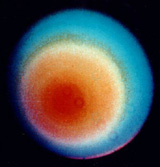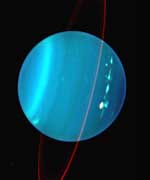Technical Data:-
| Diameter | 51800 km |
| Average Distance from Sun | 2,871 million km 19.2AU |
| Mass | 8.68 x 1025 kg |
| Size compared to Earth (Diameter) | 4x |
| Gravity compared to Earth | 0.79x |
| Surface temperature | -210°C |
| Length of Day | 17 hours 14 mins(Retrograde) |
| Length of Year | 84.01 Earth years |
| Eccentricity of Orbit | 0.046 |
| Moons | 21 |
| Density | 1.30gm/cm3 |
| Atmosphere | Hydrogen - 85% Helium - 13% Methane - 2% |
................................................................................ ................................................................................ Brief History:- Sir Wiliam Herschel discovered Uranus was a Planet in 1781, and in the same year he also discovered its moons Titania and Oberon. Later stronomers then discovered other moons and in 1977 Saturn was found to have rings. The last space probe to visit Uranus, Voyager 2, discoverd another 10 moons, measured the length of the Uranian day and detected its magnetic period. ................................................................................ ................................................................................ Though sighted many times prior to its official discovery date, it was only in 1781 that English astronomer Sir William Herschel realised that this moving speck was actually a planet and not a star. He originally opted to name it' Georgius Sidius', after the the monarch of that time, King George III. Unsuprisingly perhaps, this met with some resistance in the scientific community and it was eventually changed to 'Uranus', after the first Sky God of ancient Greek mythology.
The exact reason for this peculiar spin is unknown, though it is hypothesised that it may have been caused by a collision with a large planet-like body at some time in the distant past. When Voyager 2 passed by the planet, Uranus' South pole was found to be facing the Sun. As a consequence of this peculiar setup, the planet's poles end up recieving more energy from the Sun than its equatorial regions, though at a distance of over 2,800 million km from the Sun, the differences are tiny. Uranus' magnetic field is tilted at about 60° to the planet's axis of rotation and is offset from the planet's centre by about 17,260 km or 1/3 of its radius. Furthermore, Uranus' 'sideways orbiting position' also has ramifications on the planet's magnetic field. Specifically, it causes the magnetic field's tail to be twisted by the planet's rotation in the direction facing away from the Sun.
Though it may look rather dull and uninspiring from the images we have of it, Uranus does actually have discernible bands of clouds which move around the planet at high speed. These were first seen, albeit very faintly, by Voyager 2 in 1986, which measured their speed at 100-600hm/h. Subsequent observations by the Hubble Space Telescope have shown clearer, brighter 'clouds' at various altitudes from Neptune's core. They are thought to be created by methane crystals condensing into warm bubbles of gas. Why does Uranus appear green? The answer is simple; the methane in its atmosphere absorbs light towards the red end of the spectrum, and consequently, the only light that we see reflected from it is greeny-blue. In 1977, it was discovered that Uranus has its very own 'ring' system orbiting the planet, rather like Saturn (though somewhat less spectacular). Astronomers noticed that a star they were observing seemed to 'blink' when it passed next to Uranus, and hence discovered the first known ring system around any planet other than Saturn. The rocks which make up the rings vary in diameter from a maximum of 10m to a minimum of a few micrometres. At the last count, Uranus had 25 known moons, 9 of which were discovered by the Voyager 2 space probe. Most are named after female characters in Shakespeare plays, eg Cordelia, Ophelia, Desdemona, Juliet, Portia etc, though some of the other names used are taken from the works of Alexander Pope. |


